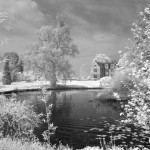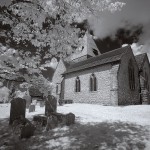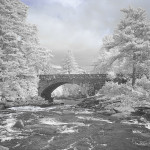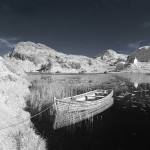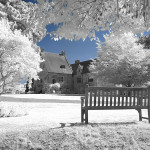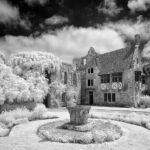Infra Red
Infra red photography is an area that has long fascinated me. I knew that it was not easy to do with film stock because it required such meticulous handling. Exposure times were an issue as light meters did not measure infra red. Infra red light also focuses at a slightly different point to visible light. One of the biggest problems was that a very dense, virtually opaque, red filter had to be fitted over the lens to prevent any visible light from reaching the film when the shutter was opened.
Infra red photographs take on an ‘other-wordly’ air. Green foliage (chlorophyll) is a great reflector of infra red and will appear as white on the image rather than a varying shade of grey as on a normal black and white photograph. A deep blue sky is an absorber of infra red and will appear almost black. The truly glorious aspect to this is that clouds, especially beautiful, fluffy cumulus clouds will appear brilliant white against that black sky. In portraiture, infra red can produce some startling effects.
Time constraints and too many other photographic projects meant that I decided not to pursue this branch of photography despite the hauntingly beautiful images it can produce … until the coming of the digital age.
Digital camera imaging chips are particularly sensitive to infra red light and camera manufacturers have to place a filter over the chip to prevent this infra red light reaching the chip and causing havoc with the image. There are companies, however, who can remove this filter for you and replace it with a filter that cuts out any visible light, thereby allowing only infra red light to reach the chip. Exposure is still a bit of guesswork but having an immediate view on the screen allows you to adjust that by altering the camera settings and repeating the shot. Reference to the camera’s histogram is a great help when judging exposure. Photoshop is a great help here and, indeed, is almost vital to get a good result.
One great benefit is that the photographer sees the scene perfectly well through the viewfinder because the filter is over the imaging chip and not the lens.
As digital technology improved I replaced my original Nikon D100 with, firstly a D200 and then a D700. This meant that I had my D100 with a perfectly acceptable 6MP chip just sitting in a camera bag doing nothing. So I decided to have it converted to shooting infra red.
One of my latest cameras to be converted to infra red is a Canon G12. This has a slightly different filter (590nm) as it can allow red and orange to pass through as well as infra red light. The use of the Channel mixer, the Hue/Saturation filter as well as the black and white filter can produce some spectacular colour effects limited only by one’s imagination and, perhaps, a modicum of ‘taste’! More recently I have had a Canon EOS M and a Canon 70D converted with filters operating in the 720nm infrared band. This is more deeply infrared sensitive than the filter in the G12 and gives wonderful crisp images with some amazing clouds and skies.
One of the pleasant side effects of Infrared photography is the wonderful clarity to the atmosphere that can be obtained. The reason for this is that haze is caused by the scattering of blue light; infrared, of course, doesn’t see any blue light so it doesn’t see any haze. As a result it sees through any haze and you get a rather ‘other-worldly’ clear visibility all the way to the horizon.






